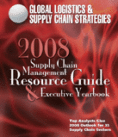
Visit Our Sponsors |
|
|
|
|
|
|
|
|
|
|
|
|
|
|
|
|
|
|
|
|
|
|
|
|
|
|
|
|
|
|
|
|
|
|
|
|
|
|
|
|
|
|
|
|
|
|
|
|
|
|
|
|
|
|
|
|
|
|
|
|

Analyst Insight
Warehouse management is an area where operations are highly likely to require support for unique processes. Over the last decade, many companies fell into a trap of over-customizing their software around their current business processes, and then were unable to upgrade their systems. Today, they find themselves a generation behind in their technology. With new advances in service-oriented architecture, companies now have the ability to configure their software around their business needs while still retaining the ability to benefit from scheduled upgrades. This amounts to companies finally having the best of both worlds in the warehouse.
- Ian Hobkirk, senior analyst, Supply Chain Execution, AberdeenGroup
Aberdeen research shows that warehouse management software is a relatively mature market. Forty-two percent of companies engaged in distribution currently have a commercial WMS, with another 28 percent using home-grown or legacy software. That leaves only 14 percent of companies with completely manual processes in the warehouse.
Companies that implement warehouse management software generally do so with the following goals in mind:
• Real-time inventory visibility-achieve live, real-time visibility of what goods have been received, picked, and shipped
• Reduced warehouse labor-reduce or eliminate searching for lost product, and utilize advanced methods like batch-picking, zone-picking, and demand-based replenishment.
• Reduced administrative labor-use of handheld computers by the warehouse workers to replace manually entering data from paper documents
• Reduced errors-tag and label each product upon entry into the warehouse, and implement automatic data capture (barcode scanning, voice, RFID) to improve accuracy.
The following capabilities have emerged as key differentiators among software providers:
• Speech-Based Warehousing: Recent advances in this area include the use of off-the-shelf, multi-function devices to facilitate speech commands. By giving workers the choice of whether to scan a barcode, speak a command, or enter data with a keyboard, the technology can be optimized around the processes, instead of the other way around.
• Slotting: Having moved away from the rudimentary spreadsheets and velocity-based systems of the past, slotting now blends the best aspects of demand forecasting, warehouse management, and labor management. The end result is a system that can not only determine where product should be located, but can recommend which product moves are worth making, and which ones will create more work than they will save.
• Labor Management Software (LMS): Technology providers are moving beyond time and attendance and historical averages and towards true engineered standards with the ability to perform XYZ coordinate mapping. In this manner, the LMS can calculate the exact amount of time it should take to perform each task, compared to the actual time.
The Outlook
WMS On-Demand. "On-Demand" applications have already transformed transportation management, and a handful of enterprising technology providers have begun offering WMS on this platform as well. Though adoption levels are still relatively low, there are numerous indications that the market will soon hit the tipping point, as companies begin to view On-Demand WMS as a safe, secure, and less expensive alternative to traditional license arrangements. Expect to see traditional WMS suppliers start releasing "On-Demand" versions of their software with basic functionality to meet this trend. Adoption will likely come from the small to mid-market segment, or warehouses that do not rely on the WMS to support high-speed automation like conveyors and sortation systems.
RELATED CONTENT
RELATED VIDEOS
Timely, incisive articles delivered directly to your inbox.


